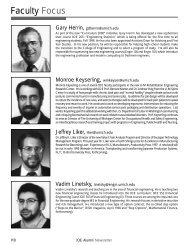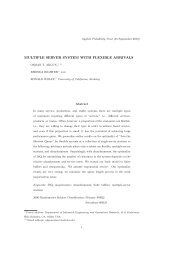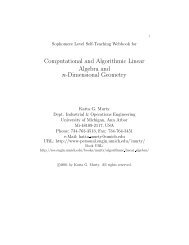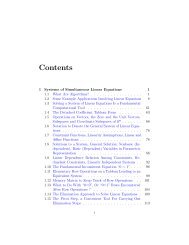Chapter 1 LINEAR COMPLEMENTARITY PROBLEM, ITS ...
Chapter 1 LINEAR COMPLEMENTARITY PROBLEM, ITS ...
Chapter 1 LINEAR COMPLEMENTARITY PROBLEM, ITS ...
You also want an ePaper? Increase the reach of your titles
YUMPU automatically turns print PDFs into web optimized ePapers that Google loves.
50 <strong>Chapter</strong> 1. Linear Complementarity Problem, Its Geometry, and Applications<br />
Extend this method into one for nding the nearest point in; = fx : x > = 0 x< =<br />
g to x 0 , where is a given number, assuming that ; 6= .<br />
(W. Oettli [1.30])<br />
1.28 Let M be a square matrix of order n and q 2 R n . Let z 2 R n be a vector of<br />
variables. De ne: fi(z) = minimum fziMi.z + qig, that is<br />
for each i =1to n.<br />
fi(z) = Ii.z if (Mi. ; Ii.)z + qi > = 0<br />
= Mi.z + qi if (Mi. ; Ii.)z + qi < = 0<br />
(a) Show that fi(z) is a piecewise linear concave function de ned on R n<br />
(b) Consider the system of equations<br />
fi(z) =0 i =1to n:<br />
Let z be a solution of this system. Let w = Mz + q. Prove that (w z) is a<br />
complementary feasible solution of the LCP (q M).<br />
(c) Using (b) show that every LCP is equivalent to solving a system of piecewise linear<br />
equations.<br />
(R. Saigal)<br />
1.29 For j = 1 to n de ne x +<br />
j = Maximum f0xjg, x ;<br />
j = ; Minimum f0xjg. Let<br />
x =(xj) 2 R n , x + =(x +<br />
j ), x; =(x ;<br />
j ). Given the square matrix M of order n, de ne<br />
the piecewise linear function<br />
TM(x) =x + ; Mx ; :<br />
Show that TM(x) is linear in each orthant of R n . Prove that (w = x + z = x ; ) solves<br />
the LCP (q M) i q = TM (x).<br />
(R. E. Stone [3.71])<br />
1.30 Let D be a given square matrix of order n, andf(x) =x T Dx. Prove thatthere<br />
exists a nonsingular linear transformation: y = Ax (where A is a square nonsingular<br />
matrix of order n) such that<br />
f(x) =y 2 1 + :::+ y 2 p ; y 2 p+1 ; :::; y 2 r<br />
where 0 < = p < = r < = n. Discuss an e cient method for nding such a matrix A, given<br />
D.<br />
Find such a transformation for the quadratic form f(x1x2x3) =x 2 1 +x 2 2 +x 2 3 ;2x1x2;<br />
2x1x3 ; 2x2x3 (this dates back to Lagrange in 1759, see D. E. Knuth [10.20]).










